Star Wars – Star Trek, Coke – Pepsi, Edison – Tesla… The history of the world is filled with iconic rivalries, but few are as intense and fierce as the competition between two tech giants.
“Brushing past each other” from the dawn of computing to the digital age today, here are 5 pairs of “frenemies” considered the most famous in the history of computing. Additionally, at the end of this article, there is a short list of other potential rival pairs that could make the list in the future.
Apple and Microsoft (Steve Jobs and Bill Gates)
This is perhaps the most famous technology rivalry of all time. The battle between Microsoft and Apple heated up in the mid-1980s and continues to this day, although it is no longer as fierce as it once was. PC or Mac, Windows or macOS, iPhone or Windows Mobile, and most recently, iPad or Surface?
However, things were not always this way. The two companies once collaborated in the early 1980s when Microsoft developed software for the Apple II. Bill Gates even joked that his company had more employees working on the Mac than Steve Jobs did.
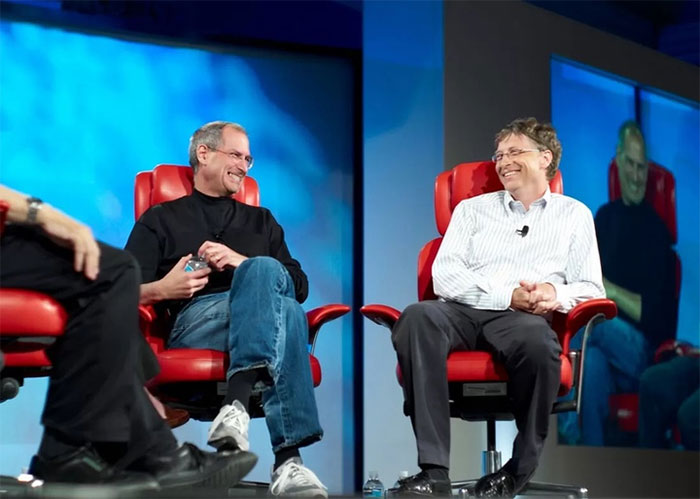
Steve Jobs and Bill Gates.
Their relationship soured after Steve Jobs accused Bill Gates of stealing the idea for the Macintosh OS to create his own graphical user interface operating system: Windows. When faced with this accusation, Bill Gates responded:
“Hey, Steve, I think there are many ways to look at this. I think it’s like we both have a rich neighbor named Xerox, and I sneaked into his house to steal the TV only to find out you had stolen it first.”
Gates was implying that the first graphical interface was developed by Xerox PARC, not Apple.
In the following decades, the duo continued to navigate a complicated relationship. They were rivals in the home computer market; however, Apple depended on Microsoft to develop applications like Word and Excel for the Mac, leading them to license some of their technology to this formidable competitor. On the other hand, Apple pursued a copyright lawsuit against Microsoft and HP, which ultimately ended in failure.
By 1997, on the brink of collapse, Apple acquired NeXT and brought Steve Jobs back as CEO. During that year’s Macworld Expo, Jobs announced that Apple had signed a 5-year agreement with Microsoft for the competitor to continue developing Internet Explorer and Office for the Mac. Microsoft also invested $150 million into the rival company, saving Apple from bankruptcy.
The following decade witnessed a strong resurgence for Apple. The iPod brought the company back to prominence. The “I’m a Mac, I’m a PC” ad campaign ran continuously for 4 years with a total of 66 episodes, attracting a large number of users to Apple’s computing world. Then the iPhone transformed the company into an unstoppable force at the top of the mobile industry, becoming the most influential tech company in history.
Today, the relationship between Microsoft and Apple is more amicable than ever, and in some respects, they seem to no longer pursue the same core interests. At one point, Microsoft’s Bing search engine was used for Siri on the iPhone. Office for Mac and iPhone is also well-received. The jabs in advertisements still exist. Tim Cook has stated that while the two companies continue to compete, they can collaborate on many other important areas. “I’m not one to hold grudges,” the CEO shared.
AMD and Intel
Intel and AMD have existed for decades. However, even though both companies were founded in the late 1960s, their rivalry only began to intensify 20 years later. Initially, things were amicable. Intel signed a cross-licensing agreement with AMD in 1976, and in 1982, the two signed a technology exchange agreement as IBM did not want Intel to be the sole chip supplier. This PC manufacturer required a second producer to participate in the production of x86 processors, leading to the agreement that granted AMD access to Intel’s second-generation 286 chip technology.
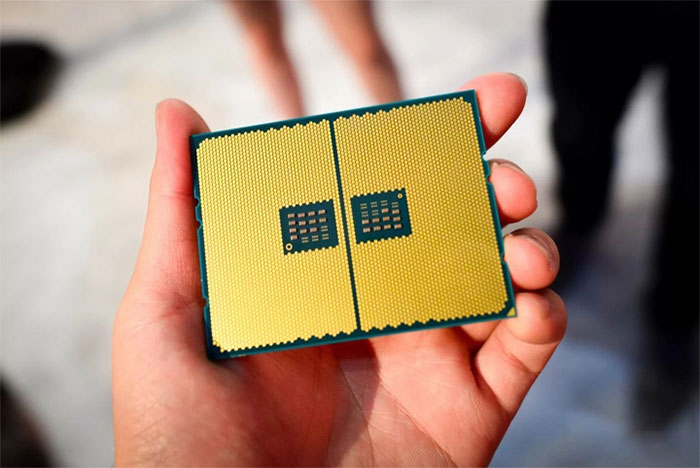
Intel and AMD have existed for decades.
This relationship began to face issues in the mid-1980s when Intel refused to grant AMD a license to use its 386 processor. AMD claimed this was part of a plan to help their rival establish a monopoly in the PC chip market, and in 1987, they accused Intel of breaching the contract signed five years earlier. AMD filed a lawsuit, marking the beginning of a lengthy legal battle.
In 1995, the two companies agreed to put their grievances aside. Intel received $58 million while AMD got $18 million along with a perpetual license to access the microcode in Intel’s 386 and 486 chips. However, some time later, the duo found themselves back in court over new lawsuits, and ultimately Intel was fined $1.4 billion by the EU for anti-competitive practices against AMD.
In the early 2000s, AMD first defeated Intel with the success of the Athlon chip line, until Intel launched the Core architecture and switched to a tick-tock cycle model, causing AMD to fall behind again, becoming the choice for those on a budget for over a decade.
Even though Intel continued to dominate the PC market, AMD has been working tirelessly in recent years, winning over tech enthusiasts and PC builders with its Ryzen and Threadripper processors. This trend is also becoming evident in other areas, where Intel was once the uncontested king but now faces a real challenge from AMD: the highly lucrative server market, and the laptop market, where AMD had little chance of competing for a long time.
AMD’s GPUs also appear in gaming consoles, with both Sony and Microsoft now equipping their next-generation consoles with Radeon graphics chips. On the other side, Intel has announced it will soon enter the GPU battle, going head-to-head with AMD not only in the consumer market but also in the data center market, where GPUs are becoming increasingly important.
Apple and Samsung
There are countless Android phones on the market, but for many people, what they care about is simply “Galaxy or iPhone.” Apple has obvious reasons to claim that Samsung is not worthy of being their rival, as the South Korean company has always tried to copy their technology and designs. With around 40 patent lawsuits, these two companies have been embroiled in a lengthy series of legal battles across various courts. Apple even managed to get some Samsung devices banned from sale in the U.S. for patent infringement.
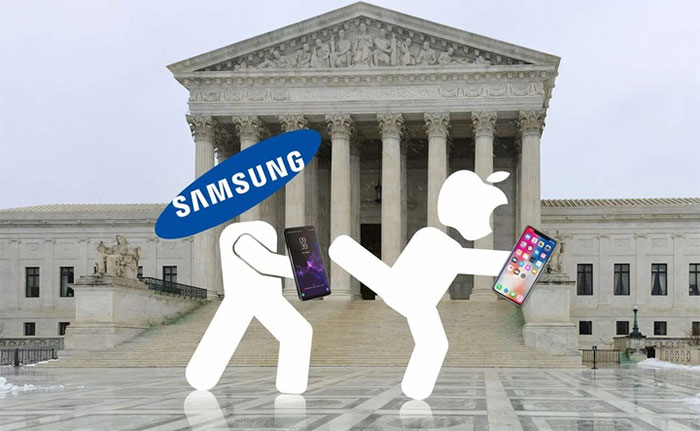
In fact, both companies have produced some of the most popular smartphones in the world.
After nearly a decade of litigation, the two companies reached a settlement in May 2018, in which Samsung had to pay Apple $539 million for infringing on the competitor’s patents. Nevertheless, this outcome was seen as a victory for Samsung, as by that time, they had become one of only two companies leading the smartphone industry.
From the consumer’s perspective, Apple fans assert that the iPhone excels in terms of ease of use, applications, and style. On the other hand, Galaxy phone owners argue that the iPhone is overpriced, and their phones are superior due to a plethora of customizable features, expandable storage, and the open nature of Android. The truth is, the flagship models from both companies are now quite evenly matched across more aspects than ever before.
In fact, both companies have produced some of the most popular smartphones in the world over the past few years. Samsung has led in sales, while Apple remains the most profitable brand for all retail partners, thanks to a comprehensive ecosystem of devices, services, and software, giving the company a unique position in the market.
Given the current situation, combined with Samsung’s commercial ads attacking the iPhone, the atmosphere of rivalry between the fans of both brands, and the continuous accusations of copying, it is easy to conclude that this rivalry will continue for many years to come.
Nintendo and Sega
Nintendo was founded in 1889 as a playing card company, while Sega emerged in 1940 as a gambling machine manufacturer based in Hawaii. Years later, this duo became fierce competitors in the world of arcade gaming, handheld devices, and gaming consoles. Sega’s arcade games turned them into a formidable force during the golden age of the gaming industry, from 1978 to 1983, but Nintendo also found success with its Game & Watch handheld devices. Nintendo’s breakthrough moment came with the release of Donkey Kong in arcades in 1981, introducing a new icon: a carpenter named Mario (who would later become a plumber in the 1983 release of Mario Bros).
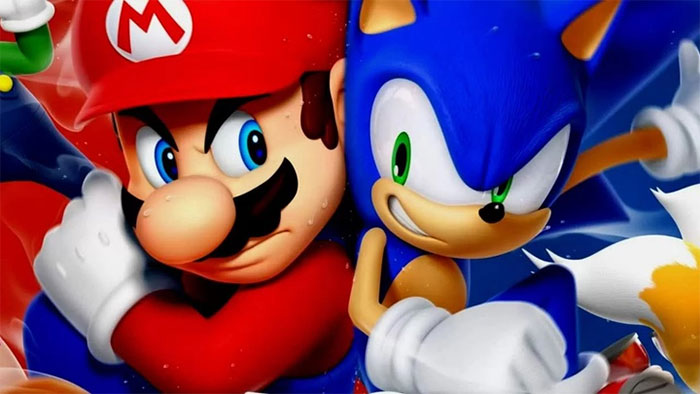
Nintendo and Sega are fierce rivals in the world of arcade gaming, handheld devices…
Nintendo has been a familiar player in the home console market since 1977 with the Color TV-Game in Japan, which had four variants, each with six versions of a game title, such as Pong. They launched a new, more successful system, the Family Computer (Famicom) in Japan in 1983, coinciding with Sega’s launch of the SG-1000 console, which was a failure for the company.
These two machines were eventually updated and redesigned for sale in North America. After the Nintendo Advanced Video System prototype failed to gain traction, Nintendo released the NES in 1985. The NES became a massive success during that period, and although Sega’s Master System was brought to the U.S. in 1986 to compete with Nintendo, it simply could not surpass the NES in popularity.
In the following years, both companies released numerous updated console models: the Super Nintendo Entertainment System (SNES) and Sega Genesis. This was also the time when one of the earliest and perhaps most famous console wars began, with slogans attacking the competitor like “Genesis does what Nintendo don’t” – Sega claimed.
Many other console and handheld gaming devices continued to be released afterward, and while Sonic the Hedgehog briefly propelled Sega ahead, the Nintendo 64 and the arrival of the Sony PlayStation sounded the first bells signaling the end of Sega’s console ambitions. The company’s final and best console was the Dreamcast in 1998. The Dreamcast sold well in North America and Europe but struggled in Japan. Not long after the PlayStation 2 was released, Sega decided to discontinue the Dreamcast. When the last unit rolled off the production line in 2001, two decades of Sega’s pursuit of console gaming came to an end.
Nintendo remains a successful gaming company and console manufacturer in the market. The Nintendo Switch has been a resounding success, and the company works hard to protect its intellectual properties, including many famous titles such as Animal Crossing, Donkey Kong, Mario, Zelda, Metroid, Splatoon, and Pokémon.
Meanwhile, Sega now primarily develops and publishes games across various platforms, including mobile/smartphone, and continues to dominate the relatively small arcade gaming market. The company also has a presence in popular culture in various forms, most notably in the recent Sonic the Hedgehog movie, marking a new milestone for video game-based films.
Google and Apple
When HTC introduced an Android phone in January 2010 with many features similar to the iPhone, Steve Jobs stated: “I will use every last breath in my body if needed, and I will spend every penny of the $40 billion that Apple has in the bank to correct this mistake“
“I will destroy Android, because it is a stolen product. I am willing to play nuclear bomb!” – Jobs added.
However, the situation wasn’t always so tense. When the first iPhone was announced in 2007, it integrated Google Search, Google Maps, and YouTube. But Google’s acquisition of the mobile startup Android Inc two years earlier had sown the seeds of animosity between the two companies. Jobs was particularly frustrated with Android, to the point of viewing it as a betrayal.
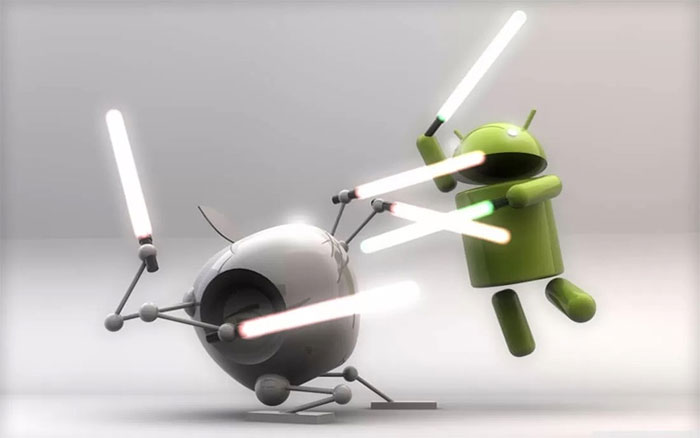
Even today, Apple and Google maintain a relationship that is considered complex.
The CEO of Google at the time, Eric Schmidt, was on Apple’s board when the Android mobile platform was announced in November 2007. He continued in this position until August 2009, when he was persuaded to resign. This marked the beginning of many years of legal battles. Apple began suing HTC, Samsung, and Google’s partners like Motorola Mobility. Jobs told Schmidt in 2010: “I don’t need your money. If you gave me $5 billion, I wouldn’t need it. I have plenty of money. I want you to stop using our ideas in Android, that’s all I want“
The relationship between the two companies hit rock bottom in 2012 when Apple replaced Google Maps with its own mapping solution in iOS 6. This software was so poor that Tim Cook had to apologize to users personally shortly after its release. It even led to the departure of Scott Forstall, the head of the mapping division. This incident is also why Apple later launched a public beta program for iOS.
Even today, Apple and Google maintain a relationship that is considered complex. The two companies continue to criticize each other and release competing products, but Google pays Apple billions of dollars each year to ensure they remain the default search engine on the iPhone. Apple receives a commission every time an iPhone or iPad displays a Google ad in the search results. The two companies also collaborate in some other areas, such as YouTube.
CEO Tim Cook is said to have a more hostile view of Facebook while being more lenient towards Google. Recently, he stated that “The Google search engine is the best thing“. Over much of the past decade, Apple and Google have shared the top positions in the rankings of the world’s most valuable brands, with Google often standing just below Apple.
Other Major Rivalries
Many new rivalries have emerged recently, or the level of competition hasn’t reached the intensity required to make it into the top 5. But who knows what might happen in a few years? What do you think about the major rivalries listed below?
- Nvidia, Intel, and Qualcomm
- Microsoft, Amazon, and Apple
- Google and Facebook
- Alibaba and Tencent
- Salesforce, Oracle, and SAP
- Netflix, Disney, and Amazon
- Tesla and the entire automotive industry
- SpaceX and Blue Origin
The 8 Most Expensive Flowers on Earth, Money Might Not Be Enough





















































